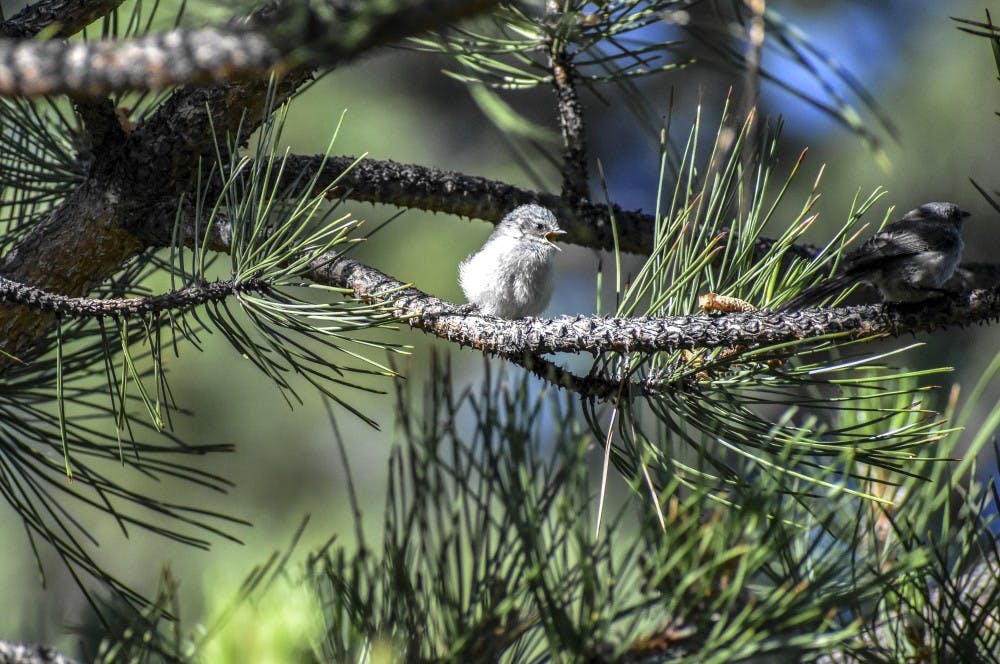Sun rays partially embraced the University of New Mexico by 7 a.m. on May 23. Shadows behind the University’s buildings mixed with brisk air as campus wildlife stirred.
Desert cottontails hopped from the safety of their dens to eat turf, kissed with fine drops of morning dew, next to robins prodding the damp earth with their beaks.
Danica Simmons, a senior majoring in biology and psychology, is enveloped by choruses sung by robins, barn swallows, goldfinches and bushtits. They fly overhead or sunbathe from various branches and ledges in front of the Centennial Engineering Building.
Searching for a nest that looks like it can hold a golf ball, Simmons is guided by the sound of rapid, piercing chirps of goldfinch offspring who are about to receive their morning meal.
Simmons is taking an independent biology study. She comes to the University at 7 a.m. on select days to walk campus and take notes on her findings.
“I am surveying campus for bird species, seeing how many we have, if they’re nesting or not and, of course, seeing how safe they are,” Simmons said. “We’re looking at the bird health and biodiversity.”
Simmons records bird species using an app called eBird. It allows her to review other users’ findings and know what birds to expect in a certain area. She also photographs and documents areas of concern for bird safety.
Simmons looks for buildings with large windows during her campus survey. Large windows can be rife areas for birds crashing into them, known as “window strikes.”
“A lot of people might think skyscrapers are the biggest culprits, but it’s actually the (buildings) that go one to three stories high, because that’s where most birds are hanging out,” she said. “Sure, they’ll fly over, but usually they’re going between trees, which aren’t as tall as skyscrapers.”
Window strikes can be decreased by installing windows with patterns that create a better distinction between a building and the sky, Simmons said.
“(Birds) don’t have our eyes. (Birds) don’t know what glass is. It’s not fair. We’re building where they’re used to flying back and forth — so of course they’re gonna crash,” she said, walking along the edge of the glass Farris Engineering Building, looking for dead birds.
Heavy construction machinery is heard as far as the Farris Engineering Building and grew louder as Simmons walked between groves of trees lining the path away from Marron Hall.
Get content from The Daily Lobo delivered to your inbox
Simmons said areas with construction do not harm birds, but can make living more difficult for them.
“There are studies (of) birds changing how loud and what sort of pitch they are singing or calling based off how loud the background noise is,” Simmons said, as sounds of bulldozers moving piles of earth and workers clanging metal ringing from the construction site roared around her.
While she walked toward the Center of the Universe, Simmons pointed out “hotspots” for Cooper’s Hawks along the treeline in front of the Elizabeth Waters Center for Dance.
Along the same line of trees, red and brown headed house finches hopped to and from different branches.
Simmons pointed out blue-backed, orange-breasted barn swallows nesting with their young in semi-circular nests that look as though they were made with the adobe of Ortega Hall.
“They carry all these beak-fulls of mud until it makes a little nest. That is a lot of freaking work for those little birds,” she said, as a swallows’ head hid behind the cover of its nest.
Between Ortega Hall and Zimmerman Library there is a shaded courtyard, partially encircled by dark green ivy plants. A water fountain sits in the middle of the courtyard and is frequented by birds. Simmons said the area is a great place to birdwatch.
“This is such a cool campus — there is so much to see if you are actually looking for it,” Simmons said, adding that she does not feel like she is at school when she loses herself in the campus flora and fauna.
Students on campus should stay on the lookout for birds in thickets or near streams making a late spring migration this May, said Museum of Southwestern Biology Director and Curator of Birds, Christopher Witt.
“It’s an exciting time of year to bird on campus, basically the spring and fall migration — late April and early May, and late August to early September — are the most fun times to bird on campus, because that’s when the diversity is pretty high, and there have been some very rare birds over the years that have been seen on campus,” Witt said.
Witt said among the diverse species on campus, there have been reports of owls, woodpeckers, black-and-white warblers, and what he said is the best species he has seen, a yellow-throated warbler.
Witt said the artificial waterfall at the top of the Duck Pond is a “hot spot” for students looking to bird.
Another location, Witt said, is at UNM’s North Golf Course.
“It’s probably the best place to birdwatch that’s really part of campus. It’s a little more wild out there, (students) can see things that are more typical of the Bosque,” Witt said.
Simmons carries binoculars and a camera with her on her walks, but she said students do not need these tools to birdwatch.
Simmons said she wants to work as a conservationist after college and she hopes that this summer’s research will help improve the safety and habitat of our winged companions on campus.
Anthony Jackson is a freelance reporter with the Daily Lobo. He can be contacted at news@dailylobo.com or on Twitter @TonyAnjackson.






